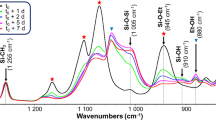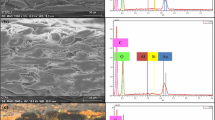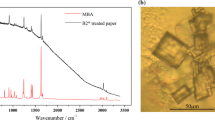Abstract
Various parameters that may affect the efficiency of tri- and di-functional aminoalkylalkoxysilanes (AAAS) copolymer treatments to deacidify and mechanically strengthen aged complex papers (lignocellulosic pulp, additives) were studied. Three model papers were first hydrothermally aged (90 °C—50% RH) in order to achieve physicochemical characteristics similar to those of a naturally aged newsprint, and were then treated with AAAS copolymers. The chemical composition of the treatments varied from 50 to 5 wt% of tri-functional monomer APTES, the latter acting as cross-linker in the copolymer network. The respective ratio of tri- and di-functional monomers in the mixture was shown to greatly influence the mechanical properties of the treated papers in the case of APTES/DIAMINO but less so in the case of APTES/AMDES. If APTES/DIAMINO (50/50 wt%) did not strengthen the degraded papers, a higher proportion of DIAMINO (95 wt%) and lower proportion of APTES (5 wt%) led to improving the tensile strength and, more importantly for the function properties of paper, significantly enhancing the folding endurance. The treatment efficiency decreased at higher state of deterioration of the papers and in the presence of alum–rosin sizing. Lastly, the treatments developed for the artificially aged model papers were applied to the degraded newsprint paper specimen and successfully enhanced its mechanical properties.
Graphical abstract






Similar content being viewed by others
References
Area M-C, Cheradame H (2011) Paper aging and degradation: recent findings and research methods. BioResources 6:5307–5337
Arnold R-B (1997) The preservation of paper: how long will the page you are reading last? Ser Rev 23:15–26
Banik G, Brückle I (2010) Principles of water absorption and desorption in cellulosic materials. Restaur Int J Preserv Libr Arch Mater 31:164–177
Browning B-L (1977) Analysis of paper, 2nd edn. Marcel Dekker Inc, New York
Casey J-P (1960) Pulp and paper chemistry and chemical technology, 2nd edn, vol 1. Interscience, Geneva
Daruwalla E-H, Nabar G-M (1956) Acid hydrolysis of cellulose. J Polym Sci Part A Polym Chem 20:205–208
Dupont A-L, Lavedrine B, Cheradame H (2010) Mass deacidification and reinforcement of papers and books VI-Study of aminopropylmethyldiethoxysilane treated papers. Polym Degrad Stab 95:2300–2308
Havlínová B, Katuščák S, Petrovičová M, Maková A, Brezová V (2009) A study of mechanical properties of papers exposed to various methods of accelerated ageing. Part I. The effect of heat and humidity on original wood-pulp papers. J Cult Herit 10:222–231
Ipert S, Rousset E, Cheradame H (2005) Mass deacidification of papers and books: study of a paper strengthening and deacidification process. Restaur Int J Preserv Libr Arch Mater 26:250–264
Ipert S, Dupont A-L, Lavedrine B, Begin P, Rousset E, Cheradame H (2006) Mass deacidification of papers and books. IV-A study of papers treated with aminoalkylalkoxysilanes and their resistance to ageing. Polym Degrad Stab 91:3448–3455
Johansson A, Lennholm H (2000) Influences of SO2 and O3 on the ageing of paper investigated by in situ diffuse reflectance FTIR and time-resolved trace gas analysis. Appl Surf Sci 161:163–169
Johansson A, Kolseth P, Lindqvist O (2000) Uptake of air pollutants by paper. Restaurator 21:117–137
Klemm D, Heublein B, Fink H-P, Bohn A (2005) Cellulose: fascinating biopolymer and sustainable raw material. Angew Chem 44:3358–3393
Lai Y-Z (2001) Chemical degradation. In: Hon N-S, Shiraishi N (eds) Wood and cellulosic chemistry, 2nd edn. Marcel Dekker Inc, New York, pp 443–512
Nevell TP (1985a) Degradation of cellulose by acids, alkalis, and mechanical means. In: Nevell TP, Zeronian SH (eds) Cellulose chemistry and its applications. Ellis Horwood Series Chemical Science, Chichester, pp 223–242
Nevell TP (1985b) Oxidation of cellulose. In: Nevell TP, Zeronian SH (eds) Cellulose chemistry and its applications. Ellis Horwood Series Chemical Science, Chichester, pp 243–265
Piovesan C, Dupont A-L, Fabre-Francke I, Fichet O, Lavédrine B, Cheradame H (2014) Paper strenghthening by polyaminoalkylalkoxysilane copolymer networks applied by spray or immersion. Cellulose 21:705–715
Piovesan C, Dupont A-L, Fabre-Francke I, Fichet O, Lavédrine B, Cheradame H (2017) The impact of paper constituents on the efficiency of mechanical strengthening by polyaminoalkylalkoxysilanes. Cellulose 24:5671–5684
Porck H-J (2000) Rate of paper degradation—the predictive value of artificial aging tests. European Commission on Preservation and Access, Amsterdam, pp 1–40
Princi E (2011) Handbook of polymers in paper conservation. Smithers Rapra Technology, Shawbury
Rychlý J, Strlič M (2005) Degradation and aging of polymers. In: Strlič M, Kolar J (eds) Ageing and stabilisation of paper. National and University Library, Ljubljana, pp 9–22
Smith R-D (2004) Paper stability and collection risk: a perspective and choices. Restaurator 25:199–210
Souguir Z, Dupont A-L, de la Rie R (2011) Chemical and physicochemical investigation of an aminoalkylalkoxysilane as strengthening agent for cellulosic materials. Biomacromolecules 12:2082–2091
Souguir Z, Dupont A-L, Fatyeyeva K, Mortha G, Cheradame H, Lavedrine B (2012) Strengthening of degraded cellulosic material using a diamine alkylakoxysilane. RSC Adv 2:7470–7478
Strlič M, Kolar J, Pihlar B (2005) Methogology and analytical techniques in paper stability studies. In: Strlič M, Kolar J (eds) Ageing and stabilisation of paper. National and University Library, Ljubljana, pp 25–40
Strlič M, Menart E, Cigič I-K, Kolar J, de Bruin G, Cassar M (2010) Emission of reactive oxygen species during degradation of iron gall ink. Polym Degrad Stab 95:66–71
Vinter Hansen B, Vest M (2008) The lifetime of acid paper in the collection of the royal library. In: Durability of paper and writing 2, 2nd International symposium and workshop, Ljubljana
Whitmore P-M, Bogaard J (1994) Determination of the cellulose scission route in the hydrolytic and oxidative degradation of paper. Restaur Int J Preserv Libr Arch Mater 15:26–45
Zou X (2002) During storage and shipping, nitrogen oxides can cause rapid yellowing and degradation of pulp and paper products. Pulp Pap Can 3:75–78
Zou X, Uesaka T, Gurnagul N (1996) Prediction of paper permanence by accelerated aging—I—kinetic analysis of the aging process. Cellulose 3:243–267
Acknowledgments
We gratefully thank the Fondation des Sciences du Patrimoine for financing Camille Piovesan’s doctoral research (ANR-10-LABX-0094-01, CoMPresSil). The participation of the Bibliothèque nationale de France in the CoMPresSil project is acknowledged.
Author information
Authors and Affiliations
Corresponding author
Electronic supplementary material
Below is the link to the electronic supplementary material.
Rights and permissions
About this article
Cite this article
Piovesan, C., Fabre-Francke, I., Paris-Lacombe, S. et al. Strengthening naturally and artificially aged paper using polyaminoalkylalkoxysilane copolymer networks. Cellulose 25, 6071–6082 (2018). https://doi.org/10.1007/s10570-018-1955-4
Received:
Accepted:
Published:
Issue Date:
DOI: https://doi.org/10.1007/s10570-018-1955-4




